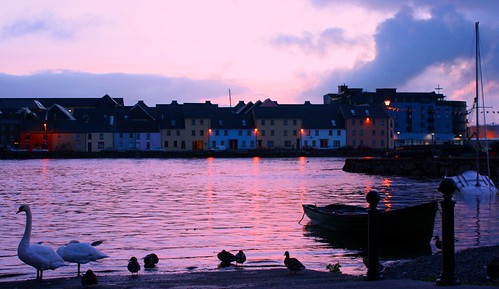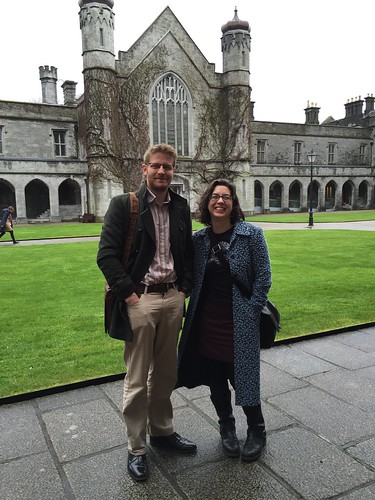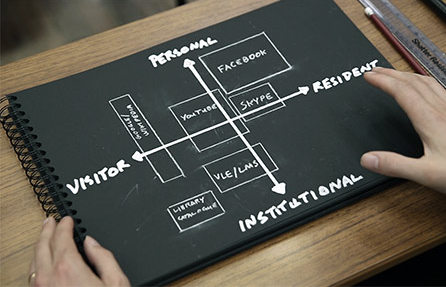
Creative Commons licensed (BY-NC-ND) Flickr photo shared by Catherine Kolodziej (Calyon)
As networked individuals each of us makes choices – on a daily and sometimes minute-by-minute basis – about how we share, interact, learn, and teach within and across different online spaces. We do this in the multiple (and often overlapping) contexts within which we work and live… as students, educators, researchers, professionals, parents, citizens, etc. In each of these roles, but perhaps particularly as educators, it is important to reflect on our identities and practices in online spaces – and how we learn and teach in those spaces. Visitors & Residents (V+R) is a tool which helps us to do this.
Last week – to celebrate Open Education Week 2015 – we were fortunate to have Dave White and Donna Lanclos here at NUI Galway to facilitate a Visitors & Residents workshop, “Marvellous Mapping”, sponsored by the National Forum for the Enhancement of Teaching & Learning in Higher Education in Ireland. Dave White is Head of Technology Enhanced Learning at the University of the Arts London and Donna Lanclos is Associate Professor for Anthropological Research at the University of North Carolina, Charlotte. Dave is the originator of the Visitors and Residents concept, and both he and Donna are on the research team that developed the related JISC infoKit.
 Creative Commons licensed (BY-SA) Flickr photo shared by catherinecronin
Creative Commons licensed (BY-SA) Flickr photo shared by catherinecronin
Thirty-five educators – lecturers, tutors, librarians, educational technologists, researchers – participated in the workshop on a gloriously sunny day here in Galway to reflect on and discuss our online identities and practices using Visitors & Residents mapping. Following is a short summary of the workshop.
Visitors & Residents – the concept
Visitors and Residents is a way of describing the range of ways we engage with the Web. In particular, V+R encourages us to think about the social traces (rather than data traces) that we leave online. In Visitor mode, you might access an online resource in a purely instrumental way, i.e. simply to get some information. In Resident mode, you view the web as a series of spaces or places; you engage with people – not just with information. As a Resident you typically have a profile, and at the extreme end of residency you are visible to others on the open web, i.e. you will show up in search results (e.g. your Twitter profile, your blog, etc.).
We are never wholly Visitors or Residents, however. Our behaviour depends on our choices and our context, i.e. what we are doing and with whom. V+R is a continuum. Somewhere in the middle of these two poles, Visitor and Resident, is where a lot of online activity happens – behavior which is “resident in character but within bounded communities”, i.e. resident behaviour which is not visible on the open web. This would include interactions within Facebook groups, within members-only wikis or discussion forums, or in module discussion boards within VLEs, for example.
V+R mapping
Dave and Donna described Visitors & Residents mapping as a useful exercise for “making the virtual visible”, and thus for reflection. The metaphor helps us to talk about the digital as a space or a place: “the web is a place where we do stuff… mapping helps make it more visible.” The two axes used in V+R mapping are a horizontal Visitor-Resident axis and a vertical Personal-Institutional (or Personal-Professional) axis. You can then add the various tools and spaces that you use to this map, locating them according to how you use them.

This is described in more detail by Dave White in the video below:
For education professionals the line is often blurry between the professional and the personal. Convergence is an interesting concept to consider: how comfortable are we with this, or do we deliberately want to separate these? There are many ways to separate the personal from the professional, or even to separate different strands within our personal and professional lives. Some people separate these by having different personas, e.g. on Facebook, Twitter, Google+, blogs, etc. Some enact boundaries by using different devices for different activities, e.g. gaming on their PC, work on their laptop, no email on their phone, etc. We make our own boundaries, consciously or unconsciously – separating or merging the different spheres of our lives. During our discussions at the workshop, there were differing opinions about this. Some found that making their personas and practices separate (personal vs. professional) made things easier, others found that this made things more difficult. One thing was clear, however, and that was that the act of mapping, of making visible, was a significant aid to both reflecting on these ideas and discussing them with others.
 During the workshop, each participant created their own map and had the opportunity to share and discuss their map with others. As a follow-on activity, Donna and Dave asked participants to think about where they might want to change their existing practices, i.e. what might they like to do more or less of? Participants annotated their maps with arrows to show the direction of these proposed changes.
During the workshop, each participant created their own map and had the opportunity to share and discuss their map with others. As a follow-on activity, Donna and Dave asked participants to think about where they might want to change their existing practices, i.e. what might they like to do more or less of? Participants annotated their maps with arrows to show the direction of these proposed changes.
When discussion moved to our practices as educators – in various roles (lecturers, tutors, learning technologists, librarians, etc.) – the VLE was the focus of some interesting debate. Some participants see the VLE moving on from being a repository to becoming/being another learning space. One participant, a tutor in a fully-online course, noted that the discussion forum within the VLE for that programme is considered to be the “heart of the course”. But what do students think? In their work with students, Donna and Dave found that many students liked the idea of the VLE as a consistent home or a hub for each module, with other connections (e.g. social media) being voluntary. As recounted by Dave, one of these students noted that they liked the fact that “there’s always somewhere to come back to”. In general, for undergraduate students, many of whom are just forming their voice, it is useful to have a home, a place to start and to return. But must this home be within a VLE, or could it be a more open, networked hub? As one participant noted, for those who operate predominantly in Resident mode it can be tough to have a VLE-based course home page. This can be “just another place to visit”, “a dead end” rather than a place on the web that can be integrated with other learning activities and networks. Compromises can surely be struck. As educators, we need to think about the best ways to facilitate a home or hub for our courses – depending on the particular course, the context, the needs and preferences of our students, and our own abilities, experience, values, and preferences.
V+R reflections
There were many other dicussions on the day, but this summary provides an overview. Overall, the workshop provided educators with an opportunity to reflect on our own online practices; to share perspectives on learning spaces, digital identities, and openness; and to consider how such insights could inform our teaching practices. The Visitors & Residents mapping exercise proved to be a useful starting point for reflecting on overall approaches to learning and teaching, for informing ways to work with students online, and for considering the relationship between the formal institution and online culture.
On a personal note, it was a joy to meet and work with Donna and Dave in Galway after connecting online for some time. Along with my co-conspirators in CELT, Sharon Flynn and Iain MacLaren, we all enjoyed the “eventedness” (thanks Dave!) of bringing the workshop to fruition. Thanks to all of the workshop participants from Galway, Donegal, Sligo, Limerick, Athlone, and Dublin (and remote participants from within and beyond Ireland) for your openness, enthusiasm, and thoughtful feedback. CELT will follow up with the specific requests for training and information which emerged during the workshop.
A video recording of the workshop is available here; and a Storify of tweets (thanks to Sharon Flynn) captures the spirit of the day very well. A reflective blog post by Mairead Seery sums up the workshop beautifully:
The take-home message for me was that even when we inhabit the digital spaces of the online world, we are seeking something very simple and fundamentally human: a sense of belonging, connection and community, moments of fellowship with others. For educators who are working to create meaningful learning experiences for students in real, online and blended learning environments, that is something worth remembering.
References:
White, Dave & Le Cornu, Alison (2011) Visitors and Residents: A new typology for online engagement. First Monday, 16 (9).
Excellent post¡ Very useful. Thanks 🙂
Reblogged this on Caroline+Kühn and commented:
Visitors+Residence in the Web